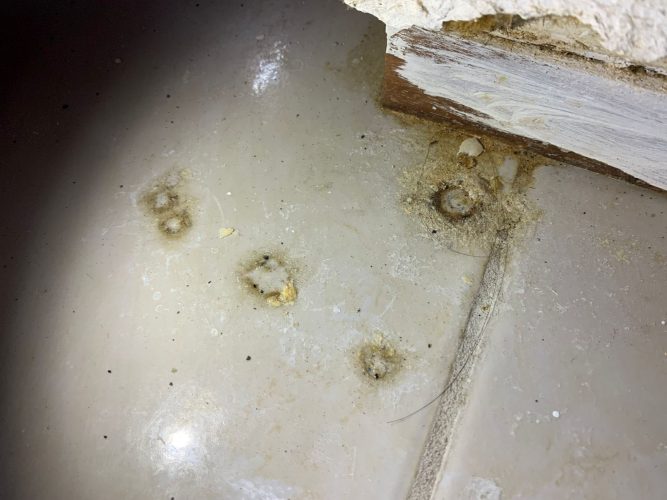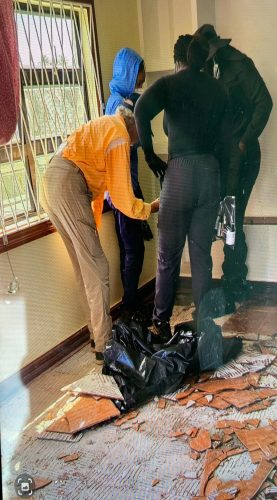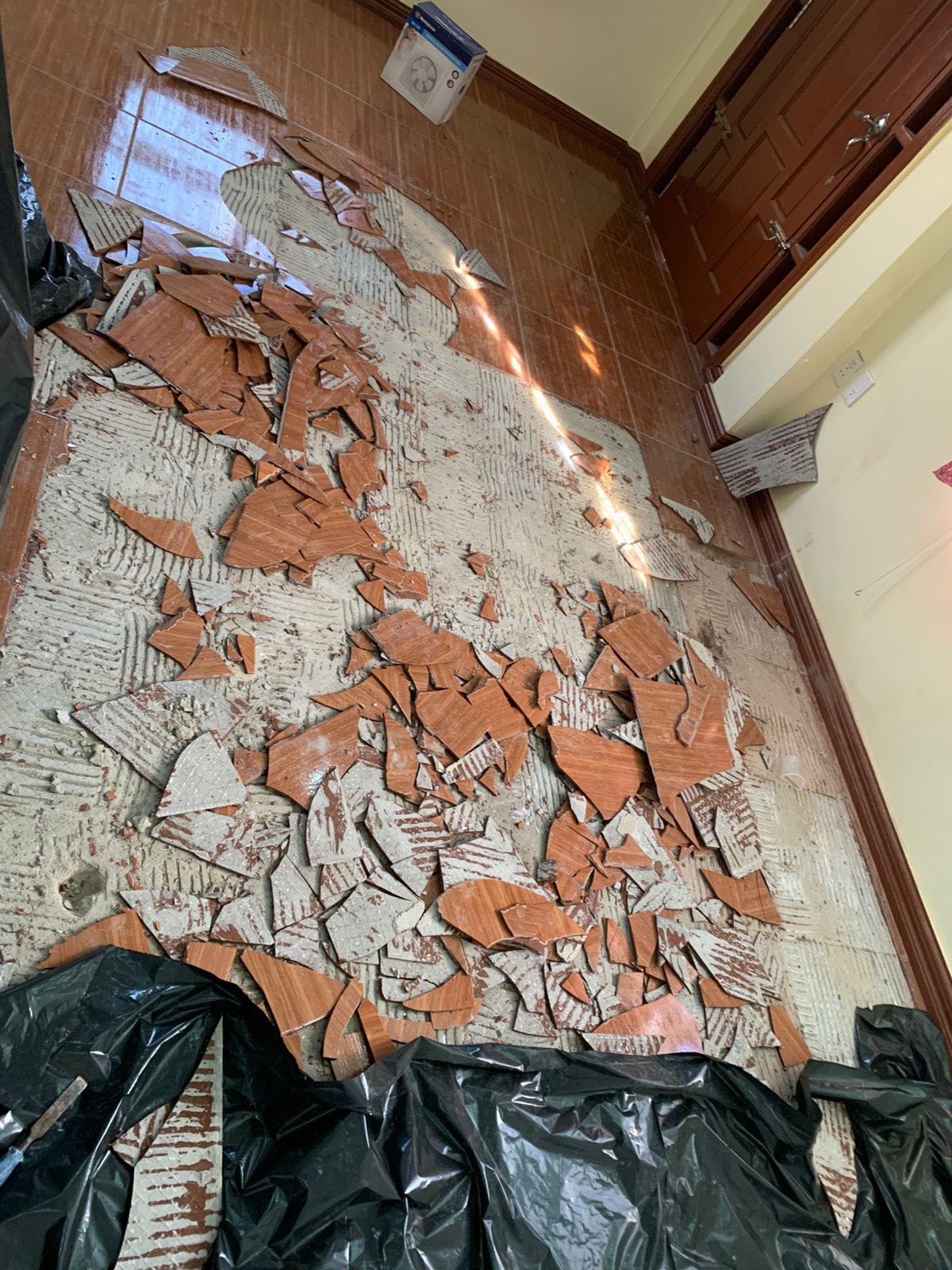-residents unimpressed with efforts of EPA, Exxon
By Milton Grannum
A number of residents of Crane on the West Coast of Demerara have spent the past month grappling with an unexplained substance seeping through the tiles in their homes, creating uncertainty and fear.
Despite several visits from the Environmental Protection Agency (EPA), and ExxonMobil Guyana Limited (EMGL) the mysterious substance remains unidentified. Frustrated residents say they are being kept in the dark about what is going on, and their lives have been thrown into chaos.
Both Basmatie Singh and Nandanie Singh, who live a stone’s throw away from each other, on Wednesday lamented their frustration with the authorities.

“These people don’t know what they doing. When they come Monday, they test for about three different things. When them done, they said they have to discuss amongst themselves. They can’t tell the owner,” Basmatie told the Sunday Stabroek.
“Why they can’t tell the owner of the house? Four people from Exxon came the last time; they had clipboards, masks, and all kinds of equipment, but they wouldn’t even tell us what they were testing for. It was like they were keeping secrets. And when they finally did say something, they told us the results were inconclusive. They didn’t say what they tested, but they said it was inconclusive”, she lamented.
The last visit to both homes saw the tiles of Basmatie’s home in the area being completely removed which uncovered a very wet area while at Nandanie’s home the air, soil and a sample of the substance was taken.

According to Basmatie, the community’s skepticism has only grown after each visit from officials. The EPA and ExxonMobil have been to both homes multiple times, and the number of personnel involved and the variety of tests conducted have increased, but results have remained elusive.
“At first, people didn’t know what was going on. But after seeing so many people coming to my house and using all this equipment, the worry spread. Neighbours are scared, especially those who live close by. They’re coming over, asking if we’re alright, and calling to check in and wondering if they have to move too. The neighbours have a rice field and I had to tell them not to burn their fields because we don’t know what effect the burning would have on the situation. When they light the rice field the entire house does get hot so I had to tell them wait until they (EPA) finish then they could light the rice field. Suppose they light it and the whole house go up in flames? Now their entire livelihood is on hold too.” And now with Diwali right around the corner she now has to celebrate outside “I will light my diyas and so, but I will just do outside because I don’t want my house to burn if this thing is combustible”. Basmatie explained.
The issue extends beyond Basmatie’s household, affecting the fabric of the community.
“When I first noticed the seepage, I thought it was just us. Now, I’m hearing other people in the area are experiencing similar things,” she continued. Basmatie recounted that another resident, who preferred to remain anonymous, heard a loud hissing noise followed by the cracking of her thick tiles. Additionally, Victor, another affected person, said he recently noticed an oily substance in his house and is considering informing his landlord that he will move. “I have two small children, and I am worried and scared,” he remarked.
Profound
The disruption to daily life in Crane is profound. Basmatie described how the seepage had forced her family to adopt a new routine. “Most nights, we can’t even sleep properly because it’s uncomfortable inside the house. Sometimes, I don’t go to bed until after midnight. We spend most of the day outside, only coming in to shower and sleep. We don’t know what else to do,” she said.
For Nandanie, the situation became even more alarming when her one-year-old son developed a bacterial infection, leading to two hospital visits in quick succession.
“He only just started walking, and you know how little children are they touch everything. We don’t know what this substance is or if it could be harmful, and now he’s been to the hospital twice”, she said.
Her fears are compounded by inconsistent information from the authorities. In the early days of the investigation, Nandanie was told that tests showed no traces of sulfur dioxide or nitrogen, and that it was safe to continue cooking in her enclosed kitchen. However, by the second visit, officials advised against cooking in the area and stated that the substance was being tested again. “One time, they said it is nothing to worry about, and I can keep cooking in the kitchen. They said it have to be the mat. One of the woman said she have a similar mat and she experiencing the same issue”, Nandanie explained. “Then the next set that came Monday said don’t cook in here and that they are testing the substance, and it will take two or three days.”
Adding to the frustrations, the EPA’s attempts to conduct soil sampling did little to alleviate concerns. According to Basmatie, officials’ procedures appeared amateurish at best.
“When they came to take soil samples, they were digging from the top layer of the dirt. Anybody who knows anything about proper soil testing knows you need to dig down to get different layers for accurate results,” she said. “The chemist who was here had to tell them you have to dig down to get the different layers of the soil.”
Doctor
Medical representatives’ visits have also been of little help. Basmatie recounted how a doctor from a local hospital visited her home but did little more than ask if she felt unwell.
“He said to call him if anything changed but didn’t give any advice on how to deal with the symptoms I am experiencing, like sore throats, red eyes, and burning skin. But when I visited a doctor at Woodlands, they said it was a chemical reaction to an unknown substance”, she related.
Basmatie’s sense of abandonment is echoed throughout the community. She criticized the EPA’s vague and inadequate communication. “They show up with masks and protective gear for themselves, but they don’t even say if we should be wearing them too,” she said.
When officials came to take tile samples, they did not bring a contractor, forcing her to hire one herself. “The EPA representative looked at the tile and said they didn’t see ‘a big set of oil pitching up’. Like is a oil well they looking for”?, she remarked.
The situation has left residents grappling with uncertainty and fear as weeks drag on without resolution. “We don’t even know when this investigation is supposed to end. It’s been weeks already, and we’re no closer to understanding what’s going on. They’re saying the tests are inconclusive, but that’s not good enough,” Basmatie insisted. “If this substance is really dangerous, we need to be advised on what to do. And if we have to move because it’s some oil thing, then we need to be properly compensated.”
In its most recent update on Tuesday the EPA stated that ExxonMobil Guyana Limited has implemented the Project Community Grievance Mechanism, which is part of its mandate, with regard to the seepage. It added that under the grievance mechanism process, EMGL was conducting an independent investigation into the seepage adding that the findings will be reported to the agency, evaluated by the EPA’s technical team, and appropriately disseminated as soon as the information becomes available.
The statement followed criticism by former EPA head Dr Vincent Adams of the agency’s handling of the situation during an AFC press conference two Friday ago.
Dr Adams had accused the agency of “pussyfooting around” suggesting that borehole drilling should begin immediately to trace the origin. He called on the government to urgently relocate affected residents to safer accommodations and show compassion towards those impacted.
He further advised that the government should procure experts in geotechnical and hydrogeological fields to conduct an independent investigation, asserting that the EPA lacked the technical expertise needed to properly assess the situation. He also questioned whether there could be a more visible source nearby, such as a leaking gas station or fuel storage tanks, adding that a leak was unlikely given the newly built gas pipeline should currently be empty.
Contacted for an update on Friday, Public Relations Officer at ExxonMobil Guyana Limited, Kwesi Isles stated that the investigations by the company are still ongoing and that information will be released shortly. Efforts made to contact the EPA via phone proved futile, however during a visit to the EPA by this newspaper on Friday, head of the communications unit, Joel Ally stated that a press release will be sent out shortly and that an interview can be conducted tomorrow with Executive Director of the EPA Kemraj Parsram for an update on the matter.
Photos: sys/y/pictures:Milton grannum/ 24-10-2024/ Exxon and EPA staff testing during the last visit on Monday, The area that was broken out in Basmaties Home, The substance in nandanie’s home.






